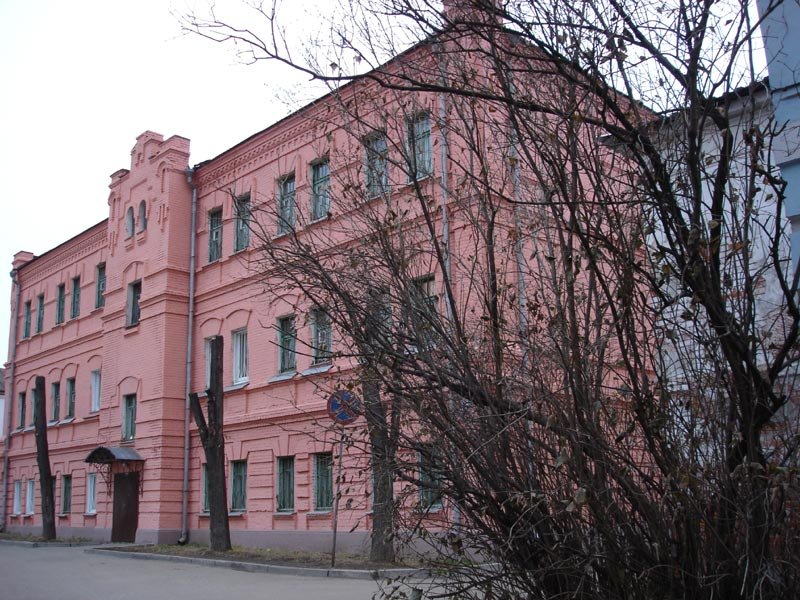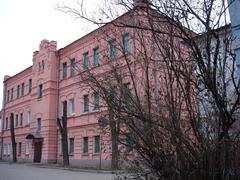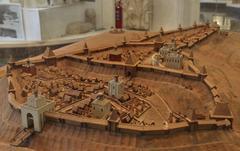
Vladimir Central Prison: Visiting Hours, Tickets, and Historical Significance in Vladimir, Russia
Date: 14/06/2025
Introduction
Vladimir Central Prison (Vladimirsky Central) stands as one of Russia’s most historically significant and culturally resonant institutions. Established in 1783 under Empress Catherine II, its imposing fortress-like structure in the heart of Vladimir has witnessed the tides of Russian history—from the Imperial era through the Soviet period and into the present day. Over centuries, it has housed notorious criminals, political dissidents, Soviet-era prisoners, and even international figures like Francis Gary Powers. Today, while still serving as an active maximum-security prison, it also operates a dedicated museum, offering a window into the complex legacy of Russia’s penal system and its cultural impact.
Visiting Vladimir Central Prison is more than a tour—it is an immersion into the socio-political fabric of Russian society. The museum’s exhibits, guided tours, and the enduring legacy of its folklore, including the iconic chanson “Vladimirsky Central,” provide unique perspectives for travelers, historians, and cultural enthusiasts alike. This guide delivers comprehensive information on visiting hours, ticketing, ethical considerations, travel tips, and nearby attractions, ensuring your experience is both meaningful and respectful.
For more detailed planning, consult resources such as visitrussia.com and Russia Beyond.
Table of Contents
- Visiting Information
- History of Vladimir Central Prison
- Museum Highlights and Exhibits
- Notable Inmates
- Cultural Resonance
- Ethical and Cultural Considerations
- Practical Travel Tips and Nearby Attractions
- Security and Safety Measures
- Frequently Asked Questions (FAQ)
- Conclusion and Final Tips
- References
Visiting Information
Opening Hours
- Museum: Open Tuesday to Sunday, 10:00 AM – 6:00 PM. Closed Mondays and Russian public holidays.
- Note: Hours may vary seasonally or for special events. Always confirm via the official website or by contacting the museum in advance.
Tickets and Admission
- Standard admission: ~300–500 Russian Rubles for adults.
- Discounts: Available for students, seniors, and groups.
- Booking: Advance booking is required. Tickets can be reserved through the Vladimir-Suzdal Museum, directly with the prison administration, or via official online portals.
- ID: Bring a valid ID for security checks and ticket collection.
Guided Tours
- Languages: Russian; English tours available with advance notice.
- Duration: Approximately 90 minutes.
- Requirement: All visits are by guided tour only, due to security protocols.
- Booking: Arrange at least several weeks in advance by phone or email.
Accessibility
- The museum is within an active prison complex, limiting some physical access.
- Ramps and accessible restrooms are available, but visitors with mobility concerns should contact the museum ahead to discuss specific needs.
How to Get There
- Location: 67A Bolshaya Nizhegorodskaya Street, Vladimir, Russia.
- From Moscow: Around 190 km east, accessible by train (2 hours from Kursky or Yaroslavsky stations), car (M7 highway), or intercity bus.
- Local transit: From Vladimir train station, a 15-minute taxi or public transport ride reaches the prison.
History of Vladimir Central Prison
Foundation and Evolution
Established in 1783, the prison initially served as a labor house for petty criminals. By the early 20th century, it hardened its focus on security and political repression, reflecting the growing turbulence of pre-revolutionary Russia.
Role in State Power and Repression
- Tsarist Era: Imprisoned revolutionaries, intellectuals, and dissidents.
- Soviet Period: Became a “politisolator” for political opponents, including high-profile Cold War detainees. Managed by the NKVD and later the KGB, it gained notoriety for its harsh conditions and inescapability.
- Modern Era: Continues as a high-security facility while also serving as a museum since 1996, documenting both penal and political history.
Museum Highlights and Exhibits
The Vladimir Central Prison Museum, curated with the Vladimir-Suzdal Museum, offers:
- Original documents from Imperial and Soviet periods.
- Personal artifacts—uniforms, hand-crafted items, and daily tools of prisoners and staff.
- Historical photographs and artwork depicting prison life and architecture.
- Reconstructed cells (including solitary), and the restored St. Nicholas Church (opened 1995).
- Multimedia presentations and thematic exhibitions on political incarceration, WWII POWs, and post-Soviet reforms.
Notable Inmates
- Vasiliy Stalin: Son of Joseph Stalin, emblematic of shifting political fortunes.
- Francis Gary Powers: U.S. pilot shot down during the Cold War, sparking international intrigue.
- Vladimir Bukovsky, Natan Sharansky, Yuly Daniel: Soviet-era dissidents whose imprisonment highlighted broader issues of repression.
- WWII POWs and Nazi officers: Reflecting the prison’s shifting roles through global conflict.
Their stories are presented through exhibits and guide narratives, deepening visitors’ understanding of Russia’s political and penal history (rbth.com).
Cultural Resonance
Folklore and Song
Mikhail Krug’s chanson “Vladimirsky Central” has immortalized the prison in Russian popular culture, symbolizing endurance and hardship. The site continues to inspire literature, art, and music that grapple with the realities of incarceration.
Public Memory
The prison’s austere architecture and storied past remain central to Russian historical consciousness, provoking reflection on justice, resilience, and state authority.
Ethical and Cultural Considerations
Respectful Conduct
- Behavior: Dress modestly, remain within designated areas, follow guide/staff instructions.
- Photography: Allowed only in authorized zones; always seek permission.
- No contact with inmates; all visits are strictly chaperoned.
Social and Human Rights Context
- The prison’s history is intertwined with stories of suffering and resilience. Ethical tourism requires visitors to approach displays with empathy, avoiding sensationalism or trivialization.
- Exhibits on women’s experiences, health, and family separation highlight gender-specific challenges in Russian penal history (bmcmedethics.biomedcentral.com).
Educational Focus
Opt for official, educational tours that contextualize the prison’s role in Russian society, justice, and human rights—eschewing exploitative or unauthorized excursions.
Practical Travel Tips and Nearby Attractions
- Wear comfortable shoes—the grounds and city sites involve extensive walking.
- Arrive early to avoid crowds and delays at security.
- Bring translation aids if not fluent in Russian; tours are primarily in Russian, though some English options exist.
- Combine with other sites: The Assumption Cathedral, Golden Gate, and Vladimir-Suzdal Museum-Reserve are all nearby and offer a broader appreciation of regional history and architecture.
- Check local recommendations for restaurants, hotels, and further tours.
Security and Safety Measures
- Screening: All visitors undergo metal detector checks and ID verification.
- Accompaniment: Visitors are escorted by authorized staff at all times.
- Emergency procedures: In place and regularly drilled; follow staff guidance.
Frequently Asked Questions (FAQ)
Q: Can I visit Vladimir Central Prison?
A: Only the museum within the prison complex is accessible, by advance arrangement and guided tour.
Q: What are the visiting hours?
A: Typically 10:00 AM to 6:00 PM, Tuesday to Sunday; confirm when booking.
Q: How do I get tickets?
A: Reserve in advance through the Vladimir-Suzdal Museum or prison administration.
Q: Are guided tours mandatory?
A: Yes, for security reasons, all visits are guided.
Q: Is photography allowed?
A: Only in designated areas; always check with guides.
Q: Is the museum accessible for people with disabilities?
A: Some areas may be difficult to access; contact ahead for accommodations.
Q: Are children allowed?
A: Yes, but parental discretion is advised due to the serious subject matter.
Conclusion and Final Tips
Vladimir Central Prison is both a living institution and a memorial to centuries of Russian justice, repression, and resilience. Its museum provides a rare, thoughtful encounter with the realities of incarceration, the stories of political prisoners, and the cultural echoes that continue to shape Russian public memory. For a meaningful and respectful visit:
- Book early, especially for English-language tours.
- Observe all rules and approach the site with solemnity and empathy.
- Explore nearby UNESCO-listed sites for a comprehensive cultural experience.
- Prepare emotionally—the content can be powerful and moving.
- Stay informed via the Audiala app and official museum channels for the latest updates, events, and planning tips.
For further reading or to plan your journey, consult these trusted resources:
References
- Visiting Vladimir Central Prison: Hours, Tickets & Historical Insights, 2024 (visitrussia.com)
- Vladimir Central Prison: History, Cultural Significance, and Visitor Information, 2024 (rbth.com)
- Visiting Vladimir Central Prison Museum: Hours, Tickets, and Historical Insights, 2024 (utnews.ru)
- Visiting Vladimir Central Prison: Hours, Tickets, and Ethical Considerations, 2024 (bmcmedethics.biomedcentral.com)


